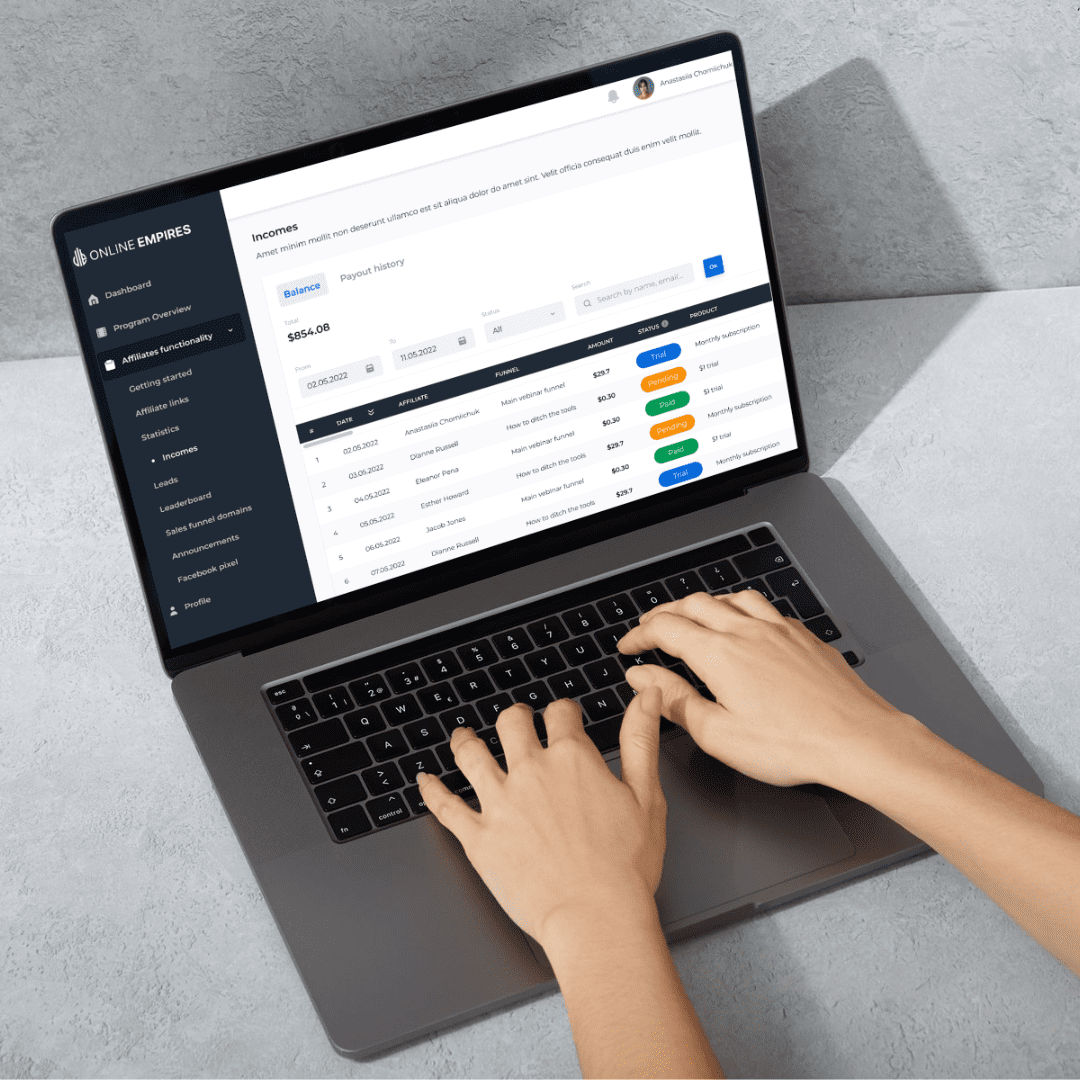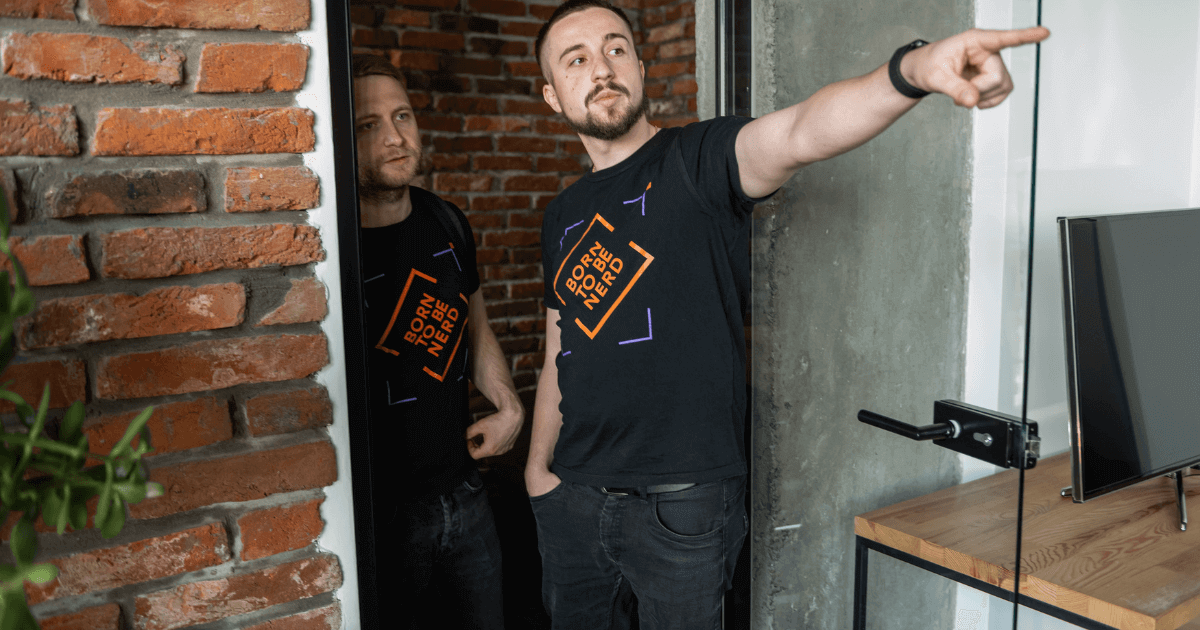От халепа... Ця сторінка ще не має українського перекладу, але ми вже над цим працюємо!

13 top eCommerce features to attract more customers and generate higher revenue

Supernerd
/
Developer
12 min read
Offering quality products is no longer enough to capture the attention of online buyers and drive conversions. To truly stand out and secure sales, you need to provide an exceptional shopping experience that sets you apart from the competition. A key strategy for reaching this goal is creating a high-quality online store equipped with top eCommerce features.
Yet, the challenge is that customer demands are constantly evolving, and new products entering the market often set higher standards for the entire industry. This means that your eCommerce software development project is always an ongoing effort. Even if you already have a functioning eCommerce solution, it’s crucial to keep track of market trends and continuously enhance them with new functionality.
NERDZ LAB has a wealth of experience developing reliable and intuitive eCommerce platforms that customers just love. In this article, we share our top eCommerce feature list with examples from real-life products built by our team. But first, let’s discuss how having the right functionality helps your business stay relevant and grow.
Article content:
- Why developing the right feature set is key to your eCommerce success
- Must-have features to meet basic customer expectations
- Extra features to differentiate your store by offering an outstanding customer experience
- Back-office features to improve your business efficiency
- Innovative eCommerce features for added value
- Wrapping-up

Why developing the right feature set is key to your eCommerce success
The number of eCommerce users is projected to grow to 3.6 billion in the next five years. This means that every second or third person on our planet will buy products online, which makes the eCommerce sector a coveted space for ambitious tech entrepreneurs.
Yet, it’s also one of the most competitive markets. A staggering 40% of respondents in the Statista eCommerce survey described their sector as “very tough” in terms of competition. For businesses venturing into eCommerce software development, this means that capturing a market share might be harder than it seems. To succeed, you need to offer customers a top-notch platform, which begins with meticulously selecting the right functionalities.
We suggest considering the following categories when compiling a top eCommerce feature list for your online store:
- Essential features that customers expect to find in every online store. Failing to include these can lead to user frustration.
- Unique features that enhance customer experience, setting your eCommerce solution apart in a crowded market.
- Administrative features that may not be visible to users but play a crucial role in improving business efficiency and the overall customer experience.
- Cutting-edge features that incorporate new technologies, helping you boost brand recognition and stay ahead.
That said, building an eCommerce software solution requires significant investment. So, it’s also critical to avoid wasting effort on features that won’t add value to users or align with your business goals.
If you partner with an experienced eCommerce development company, they’ll help you properly balance your product’s functionality. But to give you a more detailed perspective, let’s take a closer look at some top eCommerce feature examples across the above categories.

Must-have features to meet basic customer expectations
Customers today have specific expectations regarding functionality when shopping online. While these basic eCommerce features may seem trivial and obvious, overlooking any of them can greatly affect the shopping experience and lead to lost sales.
Product discovery
If customers can’t find a product in your online store, they won’t buy it. That’s why your eCommerce solution must offer fast, efficient, and seamless product discovery. This functionality typically includes:
- Searching. This allows users to find products by entering queries in a search bar. Since users often make typos or may not know the exact product name, implementing advanced search algorithms within eCommerce development is crucial. They may include keyword matching, synonym recognition, and autocomplete suggestions.
- Browsing. This top eCommerce feature helps buyers who know the type of product they’re looking for, such as a dress or a mobile phone, but are unsure about the specific model or item. Browsing capabilities let them explore options within categories, subcategories, and collections.
- Filtering and sorting. These functions allow buyers to narrow down search results by price, brand, size, color, and more. This helps them find exactly what they want faster.
However, simply having a product discovery feature isn’t enough. You need to ensure it delivers results quickly, even if your catalog is large. That’s why it’s essential to hire eCommerce developers who understand how to properly optimize database queries, implement caching mechanisms, leverage indexing techniques, and so on.

HIIVE: video shopping app for modern e-commerce.
Shopping carts
Did you know that the average cart abandonment rate is as high as 70.19%? While shoppers abandon their carts for various reasons, your goal as an online entrepreneur is to minimize the chances of this happening. Building an intuitive shopping cart within your custom eCommerce development is a key step within this task.
Your eCommerce developers must ensure each item in the cart is accompanied by essential details, such as the product name, breakdown of the price (i.e., item prices, subtotal, taxes, shipping fees), quantity, thumbnail image, etc. Buyers should also be able to modify their cart easily, for example, change quantities or remove products.
But don’t stop there. It’s also a great idea to connect your shopping cart with some back-office top eCommerce features, like analytics and inventory management. This connection will provide your business with valuable insights into user behavior, helping you better understand why carts are abandoned and enabling you to manage stock more effectively.

HIIVE: video shopping app for modern e-commerce. Learn more.
Checkout and payment methods
This is another top eCommerce feature from the must-have category that should be convenient, streamlined, and transparent. This includes:
- Straightforward forms for entering shipping and billing details.
- A pre-purchase order review so customers can check for errors and confirm their choices.
- Visual progress indicators to make the process guided and more predictable.
- A guest checkout option that allows buyers to pay for products without creating an account.
- Multiple payment methods that are secure and align with local regulations.
For example, in one of our eCommerce software development projects, DaraConnect, we built a video marketplace for a Thai client. This platform lets users buy special video messages, like birthday greetings, from Thai celebrities. Our team focused on creating a smooth checkout experience while considering country-specific limitations. As a result, we integrated various payment methods, including online and mobile banking, Thai-based PromptPay, and more, to meet the diverse needs of the client’s customers.
Intuitive design
While not a feature itself, a user-friendly eCommerce software design is fundamental for your online store’s success. And it’s not just about looking good; it’s about creating a seamless, enjoyable shopping experience that boosts sales, keeps customers coming back, and builds loyalty.
Here are the key design elements to focus on in every custom eCommerce development project:
- Easy navigation. Use clear menus, breadcrumbs, and a prominent search bar to help users find the right product.
- Informative product pages. Include high-quality images and videos, detailed descriptions, and customer reviews.
- Clear CTAs: Call to Action prompts are vital. Make buttons for actions like “Add to Cart,” “Add to Wishlist,” and “Checkout” highly visible.
- Consistent visuals: Use consistent styles, colors, and fonts; and make good use of whitespace to keep things uncluttered.
For example, in the DaraConnect project, our task was to develop a multilingual eCommerce solution, supporting both English and Thai. Thus, our team had to select fonts that were visually appealing, brand-aligned, and readable in both languages.
On another project, we had to create a UX/UI design for the client’s medicine-ordering mobile app. Our team reviewed the entire customer journey and conducted a design discovery to come up with a solution that met usability standards and aligned with the company’s mission.

DaraConnect: Creating a social media app for a celebrity video marketplace. Learn more.
Extra features to differentiate your store by offering an outstanding customer experience
Today’s shoppers have countless online stores to choose from when seeking, comparing, and purchasing products. To truly stand out, you need to go beyond the basics and add extra top eCommerce features that elevate the customer experience. By showing you care about your buyers, you’ll increase their loyalty, retention, and, ultimately, your sales.
Mobile friendliness and mobile app
Mobile has become a dominant traffic source for eCommerce. According to Statista, 77% of eCommerce website visits globally came from smartphones in the first quarter of 2024, making mobile devices responsible for two-thirds of online retail orders.
And that’s no surprise, as most people have their smartphones within reach all the time, making it convenient to shop anytime, anywhere, and increasing the likelihood of spontaneous purchases. As a retail entrepreneur, you need to cater your eCommerce solution to these behavior patterns; otherwise, you risk losing a vast chunk of your audience and significant potential revenue.
For instance, in the Hiive project, our eCommerce app development company built a user-friendly online shopping app for a client already working in retail. This client offered an AI-based marketplace optimization platform and, thus, had valuable data-driven insights into the habits, needs, and pain points of a modern audience. They commissioned our eCommerce development services to create a cutting-edge iOS app and bring more value to their customers.
Social media integration
No matter what type of eCommerce software solution you’re building or who your audience is, the chances are that your customers are active on social media. Statistics indicate that the average user spends two hours and 23 minutes daily on social platforms. As an online retailer, you can leverage this modern-day habit by integrating your eCommerce solution with Facebook, X (formerly Twitter), Instagram, Pinterest, and other popular social networks.
Here are some key integration scenarios that enhance customer experience and engagement:
- Setting up social login to simplify account creation on your store and encourage more sign-ups.
- Adding social sharing buttons to product pages to let customers easily share their favorite items with other people in their networks.
- Showcasing product reviews from social media on your eCommerce website to build trust and credibility.
For instance, in the Hiive project, we blended top eCommerce features with carefully selected social media functionality to bring the client’s vision to life. The app has a social-media-like interface and integrates with Facebook and X (formerly Twitter), allowing users to promote their favorite products through these networks.
 Online Empires: an e-learning platform with affiliate functionality. Learn more.
Online Empires: an e-learning platform with affiliate functionality. Learn more.
Discounts and loyalty programs
Who doesn’t love a good discount? They simplify our choice of a retailer, make us feel more confident in our shopping decisions, and validate our need to buy a product right now. Loyalty programs, in turn, help us build lasting relationships with businesses we buy from. In fact, a 2022 Statista survey found that 70% of buyers say loyalty programs keep them connected to a brand.
When developing these top eCommerce features, you need to ensure they’re easy to find and use at crucial touchpoints. For example, when we were building a booking platform for local Hampshire activities, our team added vouchers, promo codes, and referral options at the checkout.
Another option is to implement an affiliate program in your eCommerce solution to increase your market reach through partnerships. These programs allow you to reward your affiliates for promoting your products. For instance, in one of our e-learning projects, Online Empires, we developed an affiliate functionality that allows the client’s partners to create their own sales funnels while enabling the client to manage all affiliates and their payments efficiently.
Back-office features to improve your business efficiency
To deliver an exceptional customer experience, your business needs efficient operations. That’s why it’s important to include top eCommerce features for back-office management in the scope of your retail software development project.
Order management
Order management is the backbone of excellent customer service. That’s because this top eCommerce feature streamlines the entire process, from when the customer places an order to when the purchased product reaches their doorstep.
If an eCommerce software development project has this functionality in its scope, it typically includes:
- Order processing, which covers payment validation and updates on stock levels.
- Order tracking that provides real-time updates on order status.
- Returns and exchange management that simplifies these processes for both customers and your business.
- Automated notifications containing order confirmations, shipping updates, and delivery information.
Our eCommerce software development company has created numerous admin panels for online retail businesses that incorporate order management. One of our proudest achievements is the admin functions in a medicine-ordering app built for a UK-based client. Our team developed an efficient order management feature as a part of a web admin panel, ensuring all admin actions were automatically updated on the user side.
Reporting tools
Your eCommerce software solution will likely gather a wealth of data, so retrieving valuable insights from it is a smart move. Reporting tools are essential for this task, as they collect and present data in a clear, actionable format, allowing you to:
- Track key eCommerce metrics, such as gross/net sales, average order value, conversion rates, cart abandonment rates, and more.
- Identify bottlenecks in your processes or eCommerce solution that affect customer experience and pinpoint areas for automation.
- Gain deeper insights into customer demographics, purchase behavior, and preferences to tailor your offerings.
- Allocate your marketing budget more effectively by tracking metrics like click-through rates, conversion rates, and return on investment (ROI).
For example, in the Hampshire project, we equipped the booking platform with a reporting panel that collects user data for comprehensive analytics. The client plans to use these insights to make informed decisions about future product development and improvement.
High-speed data processing
While not a feature per se, high-speed data processing is a critical non-functional requirement for any custom eCommerce development project, so we decided to mention it, too.
Your eCommerce software solution will have to collect, manage, and store a vast array of data: product information, customer orders, payments, delivery updates, returns, and so on. Fast data processing ensures there are no lags: customers get accurate information on product availability, pricing, and promotions, while you can monitor all the updates in real-time.
One example of high-volume data processing implementation is our MunchBear project. We had to build a multitenant platform for restaurant ordering. However, the challenge was that each restaurant was a separate source of data. So, we needed to aggregate all the information while keeping data processing efficient.

Innovative eCommerce features for added value
Integrating cutting-edge features into your eCommerce solution not only positions your business as a market leader but also simplifies customer acquisition. Curious online shoppers are naturally drawn to innovative technologies, which will make your store a magnet for tech-savvy consumers seeking new experiences.
AI-powered product recommendations
While this feature is one of the most common AI use cases in eCommerce, it’s not as widespread as it may seem. Big players like Amazon, eBay, and Etsy have led the way, but for smaller stores, it’s still on the to-do list. This means you have every chance of staying ahead of the competition if you adopt this innovative technology.
On top of providing a competitive edge, AI-powered recommendations increase the likelihood of cross-selling and upselling, which is a significant business benefit. They also make the shopping experience more convenient and enjoyable as products that a customer is likely interested in just pop up on a screen — with no need to search for them in a catalog.
If you’re still hesitating to integrate AI-powered recommendations into your eCommerce solution development, consider the numbers. A significant 44% of consumers showed at least some interest in AI-driven shopping experiences, as highlighted by the PYMNTS Intelligence survey, with that figure rising for younger generations. Meanwhile, retail businesses using AI technologies experienced a two-digit growth in their sales compared to the same period in the previous year, according to Statista.

INHYPE: e-commerce mvp development. Learn more.
Video shopping
You can also transform the traditional way customers buy products online by implementing video shopping. In a global 2022 Statista survey, 46% of consumers cited the inability to touch or feel products as the main disadvantage of eCommerce. By incorporating videos into your eCommerce solution, you can help buyers see how the products look in real life, which at least partially addresses this issue.
For instance, in the Hiive project, we developed video shopping functionality for a mobile eCommerce solution. As a result, shoppers can view the products they’re interested in through other users’ video reviews and make more informed purchase decisions.
But video shopping isn’t just limited to product reviews. This innovative top eCommerce feature can take many forms, and our inHype project is a great example. The platform we developed allows customers to purchase what they like directly from live-streaming sessions. If you’re brainstorming ideas for a cutting-edge eCommerce software solution, you could consider creating a similar product but with pre-recorded shoppable demos.
Gamification
Gamification can increase customer engagement and sales by adding an element of fun to the buying process. There are numerous ways to incorporate this feature into your eCommerce solution. Here are some of the most common scenarios:
- Giving customers points and rewards for purchases or other actions like leaving a review or sharing a product on social media.
- Offering a chance to win discounts with a virtual spin wheel.
- Fostering a sense of competition among customers by creating leaderboards or rankings based on certain criteria or achievements like regular purchases or engagement levels.
You can also combine these scenarios to enhance the gamification experience even further. For instance, our eCommerce software developers integrated in-app bonuses into Eatmap, an app for discovering eateries. Customers earn rewards for visiting new places and sharing their experiences on social media. Additionally, there is a scoreboard, so app users compete with each other.

Wrapping-up
For your eCommerce solution to succeed, it must provide an exceptional customer experience and stand out in the competitive online retail market. Achieving this involves carefully selecting the right features for your platform. We suggest focusing on four main categories: essential features like search and shopping cart, advanced top eCommerce features like social media integration and loyalty programs, back-end tools like order management and reporting, and innovative features like AI product recommendations and gamification.
That said, every project is unique. If you’re unsure about the best features for your eCommerce solution, reach out to us at NERDZ LAB. With our extensive experience in eCommerce consultancy and software development services, we can help refine your idea and build a platform that meets your business goals.



